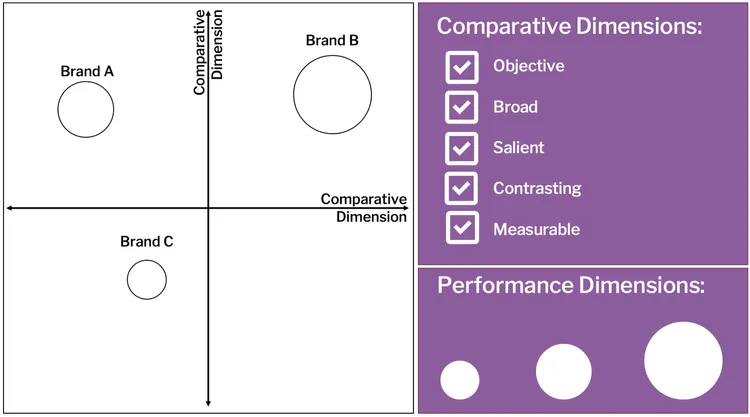Understanding Positioning Matrix
A positioning matrix is a visual representation of the different positions of competing brands in the market. Businesses can use several types of positioning matrix, including perceptual map, SWOT analysis, competitive analysis, and customer analysis.
The Perceptual map is a two-dimensional chart that shows how consumers perceive different brands in the market. SWOT analysis, on the other hand, evaluates a company's strengths, weaknesses, opportunities, and threats. Competitive analysis compares a company's brand to its competitors. Finally, customer analysis is a study of consumer behavior, preferences, and needs.

Brand Positioning Matrix
Each type of positioning matrix has its unique strengths and weaknesses. However, they all share some common components, including market segments, customer needs, brand attributes, and competitor positioning. By analyzing these components, businesses can better understand the competitive landscape of their market and identify areas where they can differentiate themselves from their competitors.
Benefits of Using a Positioning Matrix
Identification of Gaps in the Market
One of the primary benefits of using a positioning matrix is that it helps businesses identify gaps in the market. By understanding the needs of their target audience and the positioning of their competitors, businesses can develop a unique selling proposition (USP) that sets them apart from their competitors. This can help businesses attract new customers, increase sales, and build brand loyalty.
Differentiation from Competitors
In addition to identifying gaps in the market, a brand positioning matrix can help businesses differentiate themselves from their competitors. By analyzing the strengths and weaknesses of their competitors, businesses can develop a marketing strategy that highlights their unique selling points and positions them as the best option in their market segment.

Using a Brand Positioning Matrix can help businesses differentiate themselves in the market
Development of Targeted Marketing Campaigns
Another benefit of using a brand positioning matrix is that it helps businesses develop targeted marketing campaigns. By understanding the needs and preferences of their target audience, businesses can create advertising and promotional campaigns that resonate with their audience and drive sales.
How to Create a Positioning Matrix
Identify Target Market Segments
The first step in creating a positioning matrix is to identify target market segments. This involves understanding the needs and preferences of different customer groups and identifying the segments that are most likely to be interested in your product or service.
Collect Data
The next step is to collect data. This can include market research, customer surveys, and competitor analysis. The data collected should be used to create a comprehensive understanding of the competitive landscape of the market and the needs and preferences of your target audience.

How to Create a Positioning Matrix
Analyze Competitors
Once the data has been collected, businesses can begin to analyze their competitors. This involves understanding the strengths and weaknesses of their competitors and identifying areas where they can differentiate themselves.
Develop a unique selling proposition (USP): A USP is a statement that summarizes the unique benefits of your product or service and positions it as the best option in the market. By developing a strong USP, businesses can attract new customers and build brand loyalty.
Example of Competitive Positioning Matrix
The example provided includes some cars that are currently available in the UK, but it's important to note that this is not a comprehensive product position map. Instead, it serves as an illustration. If there are no cars within a particular segment, it could suggest that there's an untapped market opportunity.

For example, we have identified a potential gap in the market for low-priced family cars, but it's important to note that this gap may not necessarily exist.
There are likely a number of cars that could fit into this category, considering the competitive and well-established nature of the car market. However, this example effectively demonstrates how the positioning matrix can be utilized to pinpoint gaps within a specific market.
Limitations of Positioning Matrix
While positioning matrices can be a valuable tool in marketing, they do have some limitations.
One limitation is that they can be subjective. Different people may interpret the data differently, leading to different conclusions about the market positioning of a brand.
Another limitation is that positioning matrices are only as accurate as the data collected. If the data is inaccurate or incomplete, the resulting positioning matrix may be flawed and lead to ineffective marketing strategies.
Finally, positioning matrices are not a one-time solution. The market is constantly changing, and a positioning matrix that was effective in the past may not be effective in the future. It is important to regularly update and adjust yours to ensure that it remains relevant and effective.












Replies to This Discussion